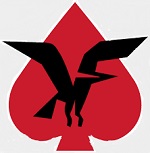Hobby Master HA4505 Israeli Defense Force Boeing F-15A Baz Multi-Role Fighter - 133 Squadron "Knights of the Twin Tail", Tel Nof, Israel, May 1978 [Low-Vis Scheme] (1:72 Scale)
"Obsolete weapons do not deter."
- British Prime Minister Margaret Thatcher
 The McDonnell Douglas F-15 Eagle is an American twin-engine, all-weather tactical fighter aircraft designed by McDonnell Douglas (now part of Boeing). Following reviews of proposals, the United States Air Force selected McDonnell Douglas's design in 1967 to meet the service's need for a dedicated air superiority fighter. The Eagle first flew in July 1972, and entered service in 1976. It is among the most successful modern fighters, with over 100 victories and no losses in aerial combat, with the majority of the kills by the Israeli Air Force.
The McDonnell Douglas F-15 Eagle is an American twin-engine, all-weather tactical fighter aircraft designed by McDonnell Douglas (now part of Boeing). Following reviews of proposals, the United States Air Force selected McDonnell Douglas's design in 1967 to meet the service's need for a dedicated air superiority fighter. The Eagle first flew in July 1972, and entered service in 1976. It is among the most successful modern fighters, with over 100 victories and no losses in aerial combat, with the majority of the kills by the Israeli Air Force.
The Eagle has been exported to Israel, Japan, and Saudi Arabia. The F-15 was originally envisioned as a pure air-superiority aircraft. Its design included a secondary ground-attack capability that was largely unused. The aircraft design proved flexible enough that an all-weather strike derivative, the F-15E Strike Eagle, an improved and enhanced version which was later developed, entered service in 1989 and has been exported to several nations. As of 2017, the aircraft is being produced in different variants with production to end in 2022.
Pictured here is a stunning 1:72 scale diecast replica of an Israeli Defense Force Boeing F-15B Baz multi-role fighter that was attached to the 133 Squadron "Knights of the Twin Tail", then deployed to Tel Nof, Israel, May 1978.
Sold Out!
Dimensions:
Wingspan: 7-inches
Length: 10-1/2-inches
Release Date: December 2015
 Historical Account: "Knights of the Twin Tail" - Israel established the 133 squadron to operate the F-15A in late 1976, receiving its first four in early December 1976. The first shipment of F-15A and F-15B aircraft was completed in 1978. Although the squadron flew missions over Lebanon in 1978, it saw its first action in June 1979 when Israeli pilots encountered Syrian MiGs over Lebanon.
Historical Account: "Knights of the Twin Tail" - Israel established the 133 squadron to operate the F-15A in late 1976, receiving its first four in early December 1976. The first shipment of F-15A and F-15B aircraft was completed in 1978. Although the squadron flew missions over Lebanon in 1978, it saw its first action in June 1979 when Israeli pilots encountered Syrian MiGs over Lebanon.
In June 1981, several F-15A aircraft escorted some F-16s of the 117 squadron that carried out a strike against Iraq's Osirak nuclear development facility. Later in the year, Israel began adding F-15C and F-15D variants to the 133 squadron. The new F-15 variants were scheduled to be transferred to a separate squadron in 1982, but the commencement of hositilies against Syria in Lebanon postponed the transfer until after fighting had ended.
In 1988, many of the F-15A and F-15B reportedly underwent several radar and engine upgrades, but the 106 squadron remained the primary F-15 squadron. During the first Gulf War in 1990, the 133 squadron remained on full alert for several months and took part in continuous air patrols until February 1991. As of July 2005, the 133 squadron flew exclusively 15A/B/D aircraft.







